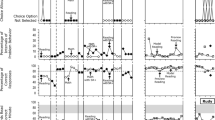Abstract
Previous research has shown that performance differences among items of serial anticipation tasks can be predicted quite well if the rated ease of learning each item, with that of its context of neighboring list members, are considered. To extend the generality of these former findings, predictor values were simplified in the present experiments. Extremely easy and difficult consonant vowel consonant (CVC) trigrams, arranged in double or triple alternation sequences, were learned by the anticipation method (continuous serial learning). Results showed extremely stable effects of item difficulty that were predicted very well despite simplification of predictors. It was suggested that the reliable carryover effects and consensus in cue selection indicated the nature of organizational processes—use of inhomogeneities as anchor points—that underlie serial learning.
Similar content being viewed by others
References
ARCHER, E. J. (1960). A re-evaluation of the meaningfulness of all possible Cvc trigrams. Psychological Monographs, 74 (10, whole no. 497).
LIPPMAN, L. G. (1971). Serial isolation effect as related to list-end demarcation. Journal of Experimental Psychology, 87, 135–137.
LIPPMAN, L. G. (1974a). List onset and isolation in continuous serial learning. American Journal of Psychology, 87, 693–698.
LIPPMAN, L. G. (1974b). Item effects as indicators of subjective organization in serial learning. American Journal of Psychology, 87, 699–705.
LIPPMAN, L. G. (1980). A re-examination of isolation-by-material in serial learning. American Journal of Psychology, 93, 99–105.
LIPPMAN, L. G. (1981a). Detection of contextual organization in serial learning. American Journal of Psychology, 94, 135–142.
LIPPMAN, L. G. (1981b). Isolation-by-material in serial learning: Supplementary report. Journal of General Psychology, 104, 235–242.
LIPPMAN, L. G. (1982). Isolation by perceptual and material disparity in serial learning. Academic Psychology Bulletin, 4, 573–578.
LIPPMAN, L. G. (1982, May). Prediction of item effects in order-learning tasks. Paper presented at the annual meeting of the Washington State Psychological Association, Eastsound.
MARTIN, E. Serial learning theory. (1973). University of Michigan Human Performance Center memorandum report 16.
MARTIN, E., & NOREEN, D. L. (1974). Serial learning: Identification of subjective subsequences. Cognitive Psychology, 6, 421–435.
Author information
Authors and Affiliations
Additional information
A version of this report was presented at the annual convention of Western Psychological Assocation, April 27–30, 1983 in San Francisco.
Rights and permissions
About this article
Cite this article
Lippman, L.G. Transitions in Item Difficulty as Sources of Organization in Serial Learning. Psychol Rec 34, 353–362 (1984). https://doi.org/10.1007/BF03394879
Published:
Issue Date:
DOI: https://doi.org/10.1007/BF03394879




